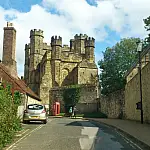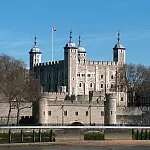History and Haunting of Tewkesbury BattlefieldTewkesbury Battlefield is the scene of one of the bloodiest battles in the War of the Roses and is haunted by those who died in battle.
On 14 April 1471, Queen Margaret of Anjou, wife of the Lancastrian King Henry VI, landed at the southwest coast of England together with her son Edward, Prince of Wales, and 1,000 mercenaries. Her husband had been imprisoned in the Tower of London by the Yorkist monarch Edward IV, and it had been Margaret's goal to wrest the crown of England back from Edward. She joined forces with the Earl of Devon and the Duke of Somerset in a campaign that shaped a part of the sequence of civil wars fought in England from 1455 to 1487, known as the War of the Roses. The red rose was the emblem of the House of Lancaster, the white rose for the House of York.
Hearing of their landing, Edward IV accumulated 6,000 troops and headed to Windsor to wait for additional information. There he discovered that the Lancastrians, with Somerset in command, had been on their approach to Wales, where they hoped to rendezvous with the forces of the Earl of Pembroke. Edward despatched orders that the gates of Gloucester were to be locked to stop the Lancastrians from crossing the River Severn into Wales at that point, and set off to intercept the enemy.
Unable to cross the River Severn at Gloucester, the Lancastrians headed for the next crossing point at Tewkesbury, with Edward IV hot on their heels. Unwilling to attempt the harmful crossing with the enemy so close, Somerset determined an alternative to turn and fight. The stage was set for one of the bloodiest and most decisive encounters of the Wars of the Roses.
On the morning of 4 May 1471, the Duke of Somerset deployed his numerical superiority, however by this time physically exhausted and militarily inferior, an army in fields to the south of the town, and the two sides prepared for battle.

The Yorkists discovered themselves hampered by way of several ditches and hedges that lay between them and their adversaries. But, having launched a bombardment of the Lancastrian lines, Edward IV gave the order to advance. At this point, Somerset came upon the Yorkist left and attacked, but the remainder of the Lancastrians did not lend their support, and Edwards cavalry soon routed Somerset's force.
This setback drained the Lancastrians' morale and, as they discovered themselves being driven back towards the town and the River Severn by the advancing Yorkists, they began to flee. Edwards infantrymen gave chase, slaughtering an enormous number of the enemy on What continues to be known as "The Bloody Meadow". To this present day, those of a psychic persuasion still pick up on the emotions of terror which are said to resonate at the spot.
Somerset, alongside his fellow commanders, took refuge in Tewkesbury Abbey, however, the Yorkists dragged them from this safe haven, tried them and executed them. The biggest loss for the Lancastrians was that of Edward, Prince of Wales, who was discovered close to a wooded area by the Duke of Clarence and summarily executed. He remains the only Prince of Wales ever to have been killed in battle.
Although the Yorkists were the victors at the Battle of Tewkesbury, 14 years later Henry Tudor would defeat Richard III (Who, as the Duke of York, had fought at Tewkesbury) at the Battle of Bosworth. Henry then married Elizabeth of York, the daughter of Edward IV, thus uniting the houses of Lancaster and York and so ending the Wars of the Roses.
Paranormal groups investigating what remains of the battlefield continue to discover and experience echoes of the skirmish. There are stories of hands abruptly becoming very cold, and a member of one team even saw a soldier in medieval armour on horseback galloping across the site.












